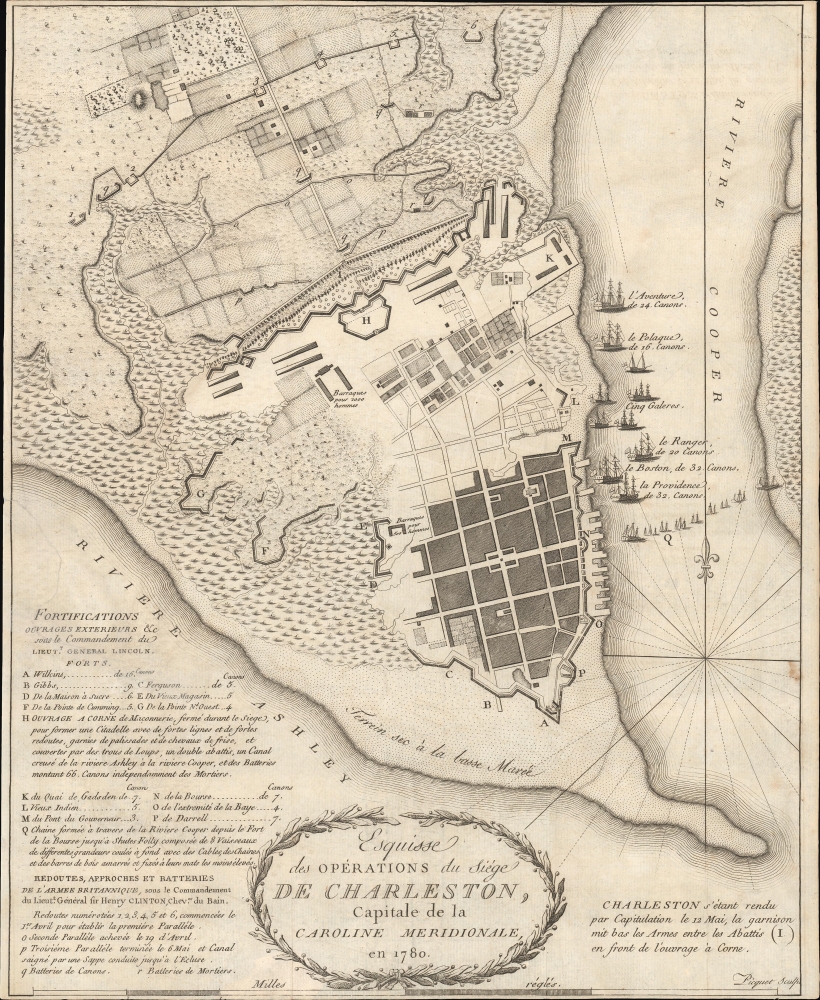1787 Picquet Map of Charleston illustrating the Siege of Charleston
Charleston-picquet-1787-2
Title
1787 (undated) 14.25 x 11.5 in (36.195 x 29.21 cm) 1 : 12000
Description
A Closer Look
The map covers the peninsular tip of Charleston and predates many of the landfills and expansions that followed as the city developed. The port is evident, as is the early grid structure. The Circular Congregational Church, which still stands and was built in 1695, is recognizable. Swampland is mapped to the west of the city, and farmland appears just north of the city's fortifications. A detailed alphabetic key situated in the lower left corner identifies 20 locations, including forts, artillery emplacements, and battle and siege lines occupied by the British Army. The number of cannons at each fort and emplacement is provided. The British fleet is illustrated in the Cooper River, with each ship identified by name and the number of cannons onboard.The Siege of Charleston
The Siege of Charleston took place from April 1 to May 12, 1780, and represented a change in British strategy based on the belief of strong Loyalist sympathies in the South. In the North, the British campaign to invade the American colonies from Quebec ended in the surrender of John Burgoyne's army after the Battle of Saratoga (which led to France and Spain entering the war on the American side). The drive to capture Philadelphia (the Revolutionary capital) ended with a British retreat back to New York City. Over some six weeks, the British, under the command of General Sir Henry Clinton, outmaneuvered the Continental defenders led by General Benjamin Lincoln. The resulting Continental defeat and surrender was the Revolutionary War's greatest single troop loss. This was the largest surrender of an American force under arms until the Union surrendered at Harper's Ferry during the American Civil War (1861 - 1865). The surrender of Charleston also left no significant American army in the South.Publication History and Census
This map was issued to accompany the 1787 first French edition of David Ramsay's (1747 - 1815) History of the Revolution of South-Carolina or, more properly, Histoire de la Revolution d'Amerique par rapport a la Caroline Meridionale. The French edition of Ramsay's history was issued 2 years after the English edition. The map, which was originally engraved by the Charleston engraver Thomas Abernethie, has here been re-engraved in French by Charles Picquet. While cartographically similar, Piquet's engraving is more sophisticated and refined. This is one of the earliest obtainable maps of Charleston and is rare on the market.Cartographer
Charles Picquet (April 15, 1771 – January 15, 1827) was a French cartographer active in Paris during the Napoleonic and post-Napoleonic Eras. Picquet was born in Romagna-sous-Montfaucon, Meuse, France. From about 1798 Picquet supplied maps to the Dépôt de la Guerre. From 1806 he was appointed to Napoleon's Cabinet Topographique. Being politically dexterous, he was able to retain this position after the fall of Napoleon under both Louis XVIII and Charles X. Under Louis XVIII he also obtained the Brevet de Géographe Ordinaire du Cabinet Topographique. He worked with the cartographer Adrien-Hubert Brué on a major atlas project. When Charles Picquet died in 1827, his son, Pierre-Jacques Picquet, continued to publish under his father's imprint name well into the middle part of the 19th century. More by this mapmaker...

